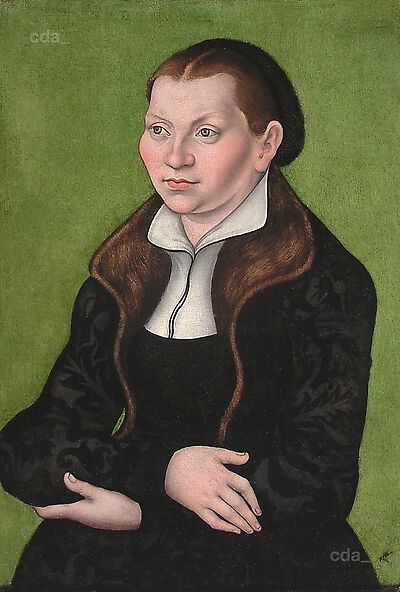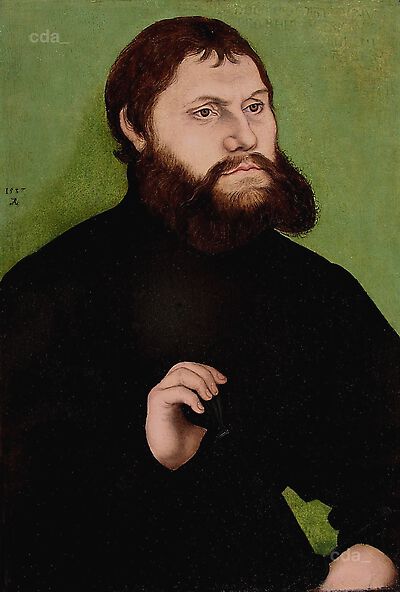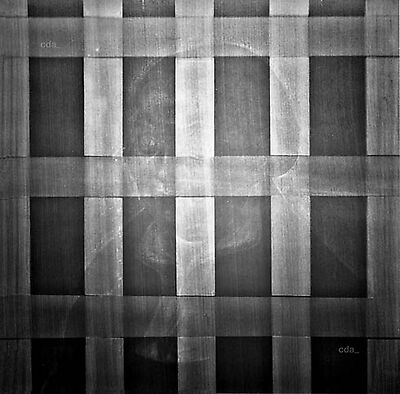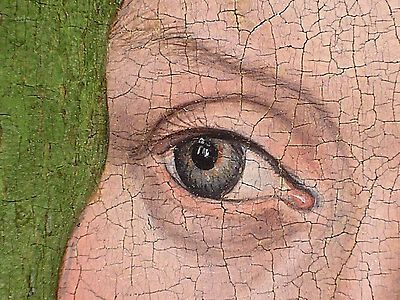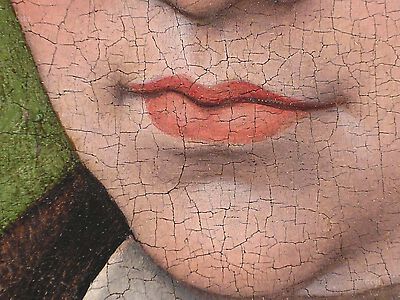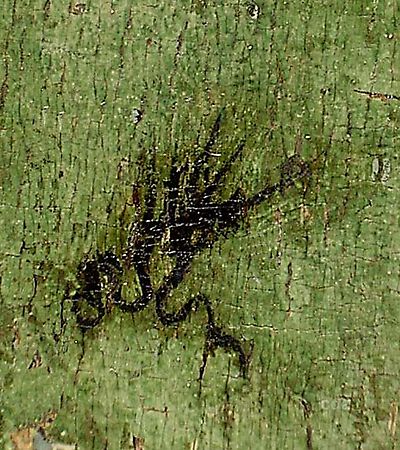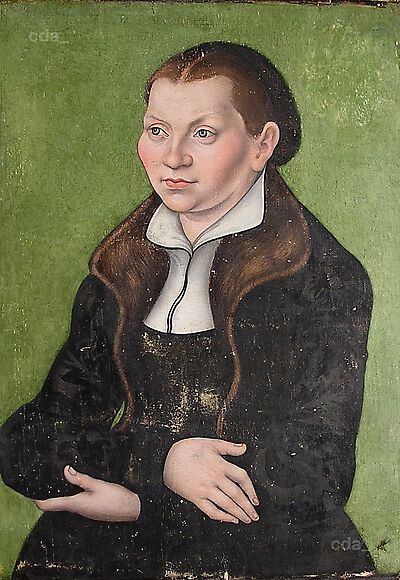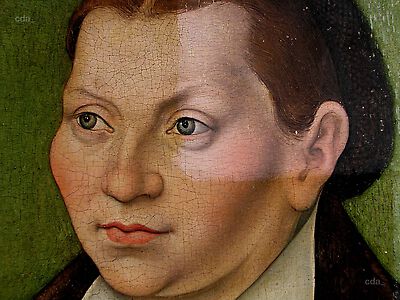Supports:
The portraits have been painted on wooden panels measuring H. 51 cm x W. 36 cm x T. .48 cm. The supports are stable and do not exhibit planar distortions or cracking. The wood has been cut tangentially with the grain running vertically. Each panel has been cradled with five vertical battens and five movable horizontal members. The backs show no inscriptions or markings except for the museum's accession numbers: 39.5 for the male portrait and 39.6 for the female. Dendrochronological examination verified beechwood (Fagus sp.) as the support material.
Ground:
The ground has been thinly and evenly applied on both panels probably white when first applied but now slightly discolored from oil staining. The gesso appears to be calcium carbonate and is well intact. There are no areas where the ground has been used as a transitional tone, although a lighter-toned outline of thinned paint is present in the upper right corner of Katharina's portrait. The gesso extends to the right and left edges on both panels: .63 cm at the top and bottom are ungessoed.
Paint Layers:
The thin paint layer has been smoothly applied with no areas of impasto. It is generally secure, although minor weak areas and losses are present along the edges of both portraits from former frame damage. In scattered areas the ground tone is visible where the paint layer has been thinned. The paint is pellicular in nature.
The backgrounds have been painted using minute smooth strokes offering seamless transitions. In general, the flesh and cloth tones are slightly thicker suggesting a careful modeling of diaphanous layers. There are no areas of visible pentimenti.
Overpaint:
An ultraviolet light examination offers clues to a painting's condition history. Organic varnishes glow a yellow-green color under such lighting. If restoration paint has been applied on top of the varnish, the area cannot glow and appears jet-black. This is referred to as 'primary fluorescence'. If a painting has been varnished more than once and the restoration work is sandwiched between the varnish layers, the ultraviolet light shows these areas as dark shadows. This is referred to as 'secondary fluorescence'. If the restoration paint is under the varnish, the surface will glow uniformly and the examination technique may offer a false positive conclusion.
The ultraviolet examination revealed secondary fluorescence within all areas of both paintings. It was most pronounced in the backgrounds and in the lower left corner of the Luther portrait. Only minor additions were evident in the flesh tones, which is not unusual since the hard lead-white pigment that predominates in these areas is less susceptible to environmental and physical damage. Museum records do not include any prior treatment documentation.
Surface Films:
The paint surfaces were coated with three distinct films. A dirt and grime film was resting on top of two organic varnish layers. Organic varnishes yellow and darken with age, thereby falsifying a painting's intended tonal relationships. Organic varnishes also serve to flatten the three-dimensional illusion of space. The portraits' overall visual qualities were severely compromised by these overlaying films.
Dendrochronology performed by Forest Products Laboratory, Madison, Wisconsin. Results received in a letter dated March 11, 2014.
Stout, George. 'Classes of Simple Paint Structure.' Technical Studies, vol. VI. 1938. p.231.
Consolidation
Scattered areas of weak paint were individually stabilized using a 1:10 gelatin adhesive. The liquid adhesive was applied warm using a small sable brush. This initial step allowed treatment work to continue without risk of further loss.
Cleaning
The cleaning of an oil painting involves the removal of discolored surface films and all areas of non-original paint. An understanding of paint chemistry is required to remove these films without injury to the surface. This work is carried out under binocular magnification using cotton swabs and appropriate solvents. The upper dirt film was removed using a mild pH-neutral detergent while the varnish layers were removed using organic solvents.
Varnish removal began along the right side of the painting. Oil paint becomes milky as it ages. As a result, darker tones will appear blanched or bloomed after cleaning. Later revarnishing reinstates a color's original richness. The below left image documents the color change that resulted from removing the overlaying films. The right image offers a corresponding detail.
The removal of earlier restoration work revealed former losses and heightened the upper-right corner's visual inconsistencies.
X-Rays/Infrared Photography
In order to determine a possible solution to the missing inscriptions, two further investigative procedures were undertaken: X-rays and infrared photography. X-rays allow conservators to understand certain aspects of a painting's condition history. They can detect holes, tears, under-drawings, and areas of former restoration work.
X-rays will pass through most objects but are blocked by pigments that contain heavy metals such as lead white; these areas appear white on x-ray film. Unfortunately, the X-rays produced no clarifying information relative to the former inscriptions and only the Katharina panel presented a reasonable image, although the backing cradle severely compromised its resolution.
Infrared photography can be used to 'see' into the layers of a painting providing information that is not visible to the human eye such as under-drawings, variations in composition, and hard-to-read inscriptions. The technique can detect carbon-based materials such as graphite and certain black pigments.
The infrared images sharpened the known letters on the first line of the Luther inscription and revealed additional information on the second line. It was now possible to read the letters P R O P H E T probably PROPHETA originally, the Latin word for prophet, and an additional S. The infrared examination of the scraped-out seal, the scraped-out lower two lines, and Katharina's upper inscription offered no clarifying information.
Filling
Filling has two purposes. It prevents further damage by sealing the edges of holes, tears, and cracks. It is also used to reproduce a sympathetic surface with respect to plane and texture. Minor areas of loss on both panels were filled with gesso, a mixture of marble dust and a 1:7 gelatin adhesive.
Varnishing
A brush coat of Winsor & Newton non-yellowing varnish was applied to the paint surfaces. Varnish is applied for several reasons. First, it reinstates the richness of the paint by allowing the darks to have their proper tone. Second, it keeps dirt and air pollution off the picture surface. Third, the surface coating protects the paint layer from damage caused by abrasion, moisture, and accidental accretions. The varnish also creates an ethical buffer between the original paint layer and the retouching or inpainting. Conservators do not paint directly on the original paint surface. The work is done on top of an isolating varnish and can be removed by simply removing the underlying varnish.
Retouching
Retouching is carried out to correct visual inconsistencies caused by inherent structural problems or surface damage. Its purpose is to reduce or eliminate these inconsistencies. It is applied only to areas of loss and should never extend over the original paint. The retouching was completed using Maimeri conservation pigments. These pigments are both color- and light-fast offering confidence that the restoration areas will remain consistent over time. Also, the pigments are soluble in mineral spirits. This relatively weak solvent permits safe and easy removal without risk of injury to the paint surface.
Ms. Jane Connell, director of collections and exhibitions, and senior curator, for the Muskegon Museum of Art, guided the retouching to include: leaving the abraded upper inscriptions in place for they did not detract from the paintings' overall aesthetic balance; softening the visual inconsistencies in the upper-right corner of the female portrait; and fully retouching the lower scraped-out losses on the Luther portrait for these areas were visually dominant and visually disruptive.
Completion
After retouching, the application of a final, non-yellowing spray varnish completed the nine-month treatment.
The portraits were x-rayed at 56 kilovolts and 3.3 milliamps for 6 milliseconds on August 18, 2013, by Ms. Tracy O'Brien and Mr. Thomas Daus from the Radiology Department at Shriners Hospital for Children in Chicago, Illinois.
Infra-red examination carried out with the assistance of Mr. Joe Barabe on March 29, 2013.
Filling, varnishing, and retouching purposes from Bradley, Morton C. The Treatment of Pictures. Cosmos Press, Cambridge, Massachusetts. 1950.
E-mail instructions dated November 20, 2013.
